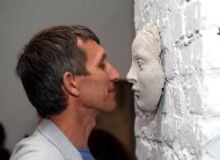The Ya Gallery has launched its new season with an exhibit of works by the noted Ukrainian sculptor Oleksandr Sukholit. The show is entitled “Clay — the Archaeology of Contemporary Sculpture.“
Sukholit’s unusual works instantly captivate the viewer with their resemblance to items unearthed during an archaeological dig. The sculptor uses unfired clay, and each one of his sculptures underlines a special spiritual dimension. It is like a genealogical search for one’s ancient roots.
How did your current project start?
The process began a long time ago and almost imperceptibly. When a sculpture would break, I would collect the fragments. The result was this homemade archaeological collection. I thought that someday I would cast these sculptures in bronze. I did that with some of them, but the thing is that bronze is different from clay. That was when I got the idea to let people see the nobility of clay.
You place your works outdoors, exposing them to the elements. Why do you do this?
I’m not Rodin, who had a brother who collected and formed all his works. It would be great if I had someone who would follow me around, collecting everything that I have touched and turning it into material. I couldn’t shape all my works myself because there were hundreds of them. When they piled up at the studio and began getting in the way, I picked those that I thought weren’t good enough and put them outside. I wasn’t out to ruin them; on the contrary, I wrapped them in polyethylene sheets and tried to save them. But many of them ended up getting destroyed. Of course, I’m sorry this happened, but as you can see, they’ve given birth to other projects.
Toward the end of the 1980s you were one of the founders of the Azbuka group. What was its goal?
I must have been born with an inclination toward mystification. During that period, I was not very familiar with religion and its main principles, and I was intuitively searching for a deity through mysticism, which exists in art. Every work of art has a vital power that has an effect on me. Gradually, I became aware of this and finally developed a formal practice that strips things down to the bones. The result was a hierarchy of space, which is firmly linked with a spiritual hierarchy. The members of our group worked on small sculptures, but the most important thing was that purely intellectually and through the senses, in a spiritual sense, we grasped the place of plastic art in the world order, that conceptual part of it that was invented by God Himself. After that, reading sculpture and its symbols became very easy for me.
What kind of viewers are your works intended for? What kind of feelings are you trying to awaken in them?
I’m not trying to awaken anything in anybody. I want to awaken this in myself. If I did what I’m doing for someone else, I would be totally unfair. People simply attend a show, and they see something that is familiar, something that belongs to world culture. I never choose my viewers. They choose themselves.
Oleksandr Sukholit was born in 1960 in Chernihiv oblast. A member of the National Artists’ Union of Ukraine, he graduated from the Chernihiv College of Decorative and Applied Art (1979) and the Department of Sculpture at the Kyiv State Institute of Art (1986; today, the National Academy of Fine Arts and Architecture). He studied under Makar Vronsky. Sukholit has taken part in more than 14 solo and group exhibits in Ukraine and 12 abroad. His works are known in Yugoslavia, Hungary, Belgium, Japan, Great Britain, France, and Denmark. He lives and works in Kyiv.







